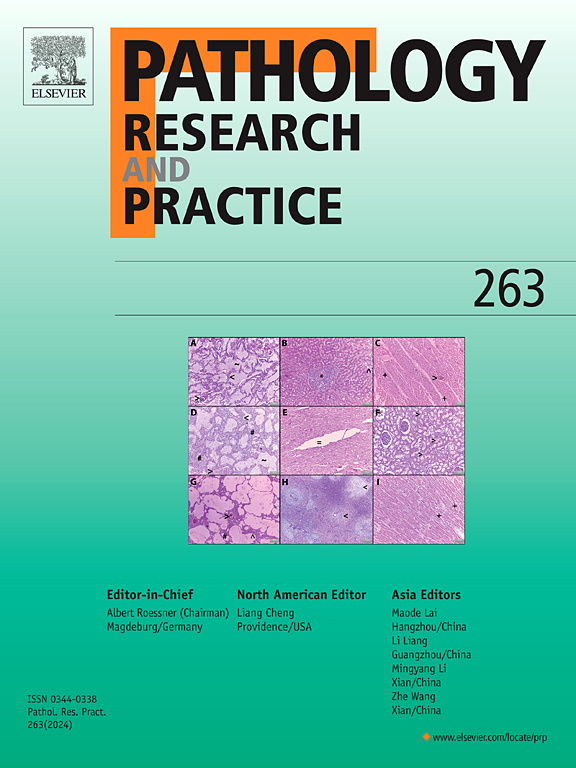C5ORF13通过eIF6促进肝癌上皮-间质转化的机制及丙戊酸的干预
IF 3.2
4区 医学
Q2 PATHOLOGY
引用次数: 0
摘要
目的探讨C5ORF13通过与真核翻译起始因子6 (eIF6)相互作用促进肝细胞癌(HCC)上皮-间质转化(EMT)的机制及其临床意义,并探讨丙戊酸(VPA)作为eIF6抑制剂在HCC中的潜在应用价值。方法应用GEPIA、UALCAN和The HUMAN PROTEIN ATLAS数据库分析C5ORF13在HCC中的表达及其对预后的影响。采用慢病毒转染技术敲低或过表达C5ORF13和eIF6。通过CCK-8、scratch、Transwell实验和动物模型评估其对HCC细胞生物学行为的影响。利用免疫共沉淀和免疫荧光共定位技术验证了C5ORF13和eIF6的相互作用。采用分子对接、CETSA实验、Western Blot等方法研究eIF6抑制剂VPA对eIF6的作用机制。结果sc5orf13在HCC中高表达,与肿瘤分期、肿瘤分级、淋巴结转移及患者预后不良有显著相关性。C5ORF13基因敲低可显著抑制HCC细胞的增殖、迁移、侵袭和EMT过程。C5ORF13在HCC细胞中与eIF6相互作用,C5ORF13通过调节eIF6蛋白表达促进EMT和HCC转移。体内实验进一步证实,敲低C5ORF13或eIF6可显著抑制HCC细胞的肺转移。临床样本分析显示,C5ORF13和eIF6在HCC组织中的表达明显高于正常组织,且两者的表达呈正相关。此外,VPA通过与eIF6结合,抑制其表达,进而抑制HCC细胞的迁移、侵袭和EMT过程,从而降低了eIF6蛋白的稳定性。结论c5orf13通过提高eIF6水平推动HCC的恶性进展,包括增殖、侵袭、迁移和EMT过程。VPA作为eIF6抑制剂,在HCC治疗中具有潜在的应用价值。本文章由计算机程序翻译,如有差异,请以英文原文为准。
Mechanisms of C5ORF13 in promoting epithelial-mesenchymal transition in hepatocellular carcinoma via eIF6 and the intervention of valproic acid
Objective
To investigate the mechanism by which C5ORF13 promotes epithelial-mesenchymal transition (EMT) in hepatocellular carcinoma (HCC) through interaction with eukaryotic translation initiation factor 6 (eIF6) and its clinical significance, and to identify the potential use of valproic acid (VPA) as an eIF6 inhibitor in HCC.
Methods
The expression of C5ORF13 in HCC and its prognostic impact were analyzed using GEPIA, UALCAN, and The HUMAN PROTEIN ATLAS databases. Lentiviral transfection technology was used to knock down or overexpress C5ORF13 and eIF6. The effects on the biological behavior of HCC cells were assessed using CCK-8, scratch, Transwell assays, and animal models. The interaction between C5ORF13 and eIF6 was verified using co-immunoprecipitation and immunofluorescence co-localization techniques. Molecular docking, CETSA experiments, and Western Blot were utilized to investigate the mechanism of action of VPA (an eIF6 inhibitor) on eIF6.
Results
C5ORF13 was highly expressed in HCC and significantly correlated with cancer staging, tumor grading, lymph node metastasis, and poor patient prognosis. Knockdown of C5ORF13 significantly inhibited the proliferation, migration, invasion, and EMT process of HCC cells. C5ORF13 interacted with eIF6 in HCC cells, and C5ORF13 promoted EMT and HCC metastasis by regulating eIF6 protein expression. In vivo experiments further confirmed that knockdown of C5ORF13 or eIF6 significantly inhibited lung metastasis of HCC cells. Clinical sample analysis showed that the expression of C5ORF13 and eIF6 in HCC tissues was significantly higher than that in normal tissues, and the expression of both was positively correlated. Additionally, VPA reduced the protein stability of eIF6 by binding to it, inhibiting its expression, and subsequently suppressing the migration, invasion, and EMT process of HCC cells.
Conclusion
C5ORF13 drives the malignant progression of HCC by increasing eIF6 levels, including proliferation, invasion, migration, and the EMT process. VPA, as an eIF6 inhibitor, shows potential application value in the treatment of HCC.
求助全文
通过发布文献求助,成功后即可免费获取论文全文。
去求助
来源期刊
CiteScore
5.00
自引率
3.60%
发文量
405
审稿时长
24 days
期刊介绍:
Pathology, Research and Practice provides accessible coverage of the most recent developments across the entire field of pathology: Reviews focus on recent progress in pathology, while Comments look at interesting current problems and at hypotheses for future developments in pathology. Original Papers present novel findings on all aspects of general, anatomic and molecular pathology. Rapid Communications inform readers on preliminary findings that may be relevant for further studies and need to be communicated quickly. Teaching Cases look at new aspects or special diagnostic problems of diseases and at case reports relevant for the pathologist''s practice.

 求助内容:
求助内容: 应助结果提醒方式:
应助结果提醒方式:


